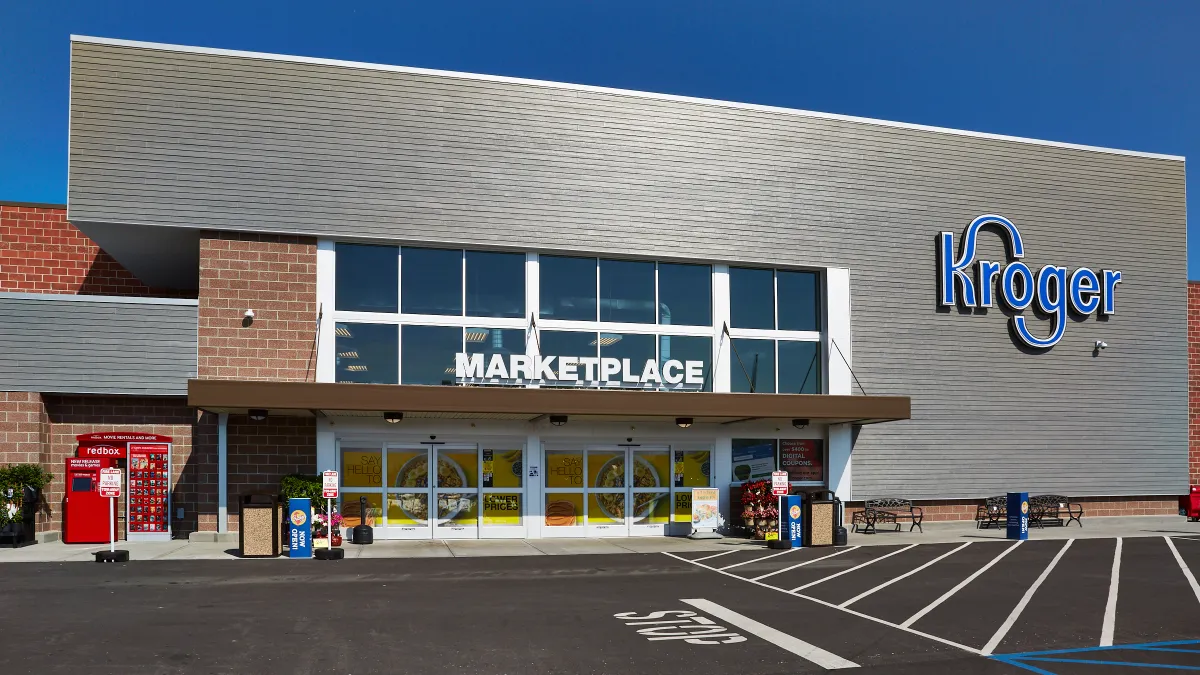Dive Brief:
- Kroger’s business grew at a brisk pace in the second quarter as the grocer continued to benefit from the heightened focus on eating at home caused by the pandemic. The company’s sales hit $30.5 billion for the three-month period that ended Aug. 15, an 8% year-over-year increase, while comparable-store sales growth came in at 14.6%, down from the 19% level Kroger reported in the first quarter. Operating profit fell to $820 million after exceeding $1.3 billion in the first quarter.
- Digital sales rose 127% in Q2 as Kroger capitalized on sustained interest by consumers in ordering groceries online. Digital orders became profitable during the quarter on an incremental basis, Chief Financial Officer Gary Millerchip said during Friday morning's earnings call, as demand and advertising revenue outpaced the company's cost to fulfill.
- Kroger expects to post an identical store sales gain for the full year of at least 13%, and predicts earnings per share, a key indicator of profitability, will rise between 45% and 50%. Kroger also said it expects that the robust results it has seen because of the pandemic will carry over to 2021.
Dive Insight:
Kroger is continuing to reap the rewards that come from running thousands of grocery stores at a time when eating out remains decidedly out of favor across the nation. However, the grocer’s latest financial report indicates that the impact of the pandemic on its business has begun to moderate.
While the supermarket operator’s business is continuing to grow strongly, the fact that the rate of increase is slower for several key measures, including overall and comparable-store sales, is a sign that, at least for Kroger, the biggest effects of the public health crisis may be behind it.
In another sign its business is stabilizing, Kroger is again providing a forecast of where it sees its business going during the rest of 2020. The grocer declined to offer updated guidance when it announced its first quarter earnings, citing the high level uncertainty posed at the time by the pandemic.
"While there are still clearly many unknowns ... we now have greater clarity in many areas of our business and the drivers of food-at-home consumption," Millerchip said during Friday morning's earnings call.
In line with national trends, Millerchip along with CEO Rodney McMullen said Kroger customers are buying less frequently than normal but building bigger baskets when they do. The grocer has gained market share in fresh categories, McMullen said, and has seen sales recently flow back into more discretionary categories like bakery and floral, indicating a return to normalcy in shopping behaviors.
While the breakneck speed at which its overall business had been racing ahead may have come down a bit, Kroger’s digital operations continue to rise at an outsize rate. The 127% rate at which the company’s online sales increased on a year-over-year basis during Q2 was significantly ahead of the 97% level it saw in Q1, reflecting the growing importance of pickup and delivery services to the grocery industry.
Millerchip said Kroger expects to boost online profitability through increased personalization, automation and the continued growth of the grocer's media business. The company currently offers pickup from around 2,100 stores and delivery from around 2,400 locations.
Kroger’s digital expansion in Q2 put it behind publicly traded rival Albertsons, which saw its online operations surge 276% and same-store sales rise 26.5% in its most recent quarter. But while Kroger’s quarterly results cover operations through the middle of August, Albertsons’ numbers reflect sales during an earlier point in the pandemic, when stay-at-home orders were the norm in many parts of the country.
Ahold Delhaize also saw its business jump strongly ahead in Q2, with identical sales ahead of Kroger's. Comp sales in Ahold Delhaize's U.S. operations rose 20.6%, and online sales growth topped 127% compared with the same period in 2019.
In a sign that the online grocery segment may have slowed, delivery and pickup sales reached $5.7 billion in August, down from $7 billion in June, when they hit an apex, according to a survey from conducted by Brick Meets Click and Mercatus.
Kroger's alternative revenue streams, including its personal finance and digital marketing businesses, saw improved results during the second quarter as the company refocused on them, and are on track to generate $100 million in fiscal 2020. Kroger Precision Marketing saw revenue growth double over the first quarter.
McMullen said Kroger remains committed to its Restock growth strategy as the impact of the pandemic gets further baked into the economy.
"Under Restock Kroger, we have made significant investments to establish a seamless digital ecosystem, strengthen Our Brands and our personalization capabilities, and to enhance product freshness and quality," he said. "These investments, combined with how our associates have responded to the pandemic and customers eating more meals at home give us confidence that Kroger’ performance in both 2020 and 2021 will be even stronger than previously anticipated."
Jeff Wells contributed reporting to this brief.













